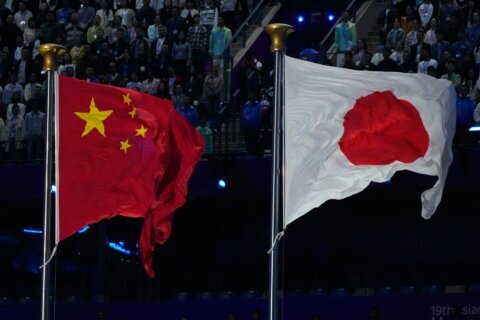“No child of God should ever suffer such a horror,” President Donald Trump said of the Syrian people on April 6, 2017, hours after ordering the launch of $60 million worth of Tomahawk missiles at an air base the Bashar Assad regime used to stage a sarin gas attack against its own citizens.
A year later, and amid Trump’s intention to withdraw U.S. forces from Syria, the regime still uses chemical weapons to kill its people. The residents of eastern Ghouta as recently as March reported what are believed to be chlorine gas attacks as government forces backed by the Russian military and Iranian proxies continue their annihilation of the former rebel strongholds.
Though it notably has not employed sarin gas again in the last year, the regime’s weaponization of chemicals like chlorine has by some accounts grown more insidious. It develops cleverer disguises for deploying them, and remains covered by an increasingly sophisticated Russian disinformation campaign set to cast doubt on who employed these weapons or whether they were used at all.
The Tomahawk strike a year ago Friday proved the effectiveness of a limited military campaign, though not without repercussions for the U.S. And the surprise attack — like most military action alone — has done little to effect the kind of lasting peace Trump pledged he could deliver. Stability for Syria, according to experts and analysts, depends on tedious and protracted efforts by diplomats and aid workers backed by clear and decisive policy.
As the administration pulls away from Syria, and considers how it will handle other combative enemies around the globe such as Iran and North Korea, it’s not clear whether Trump has learned this lesson.
“There are sound reasons for threatening and using military action in limited circumstances,” says Thomas Countryman, who until January 2017 served as the top State Department official for arms control and nonproliferation. “Those reasons ought to be thought out before you do it.”
In this case, it was likely not a coincidence that the Syrian sarin attack followed the Trump administration’s policy shift days earlier that it would not seek regime change amid the ongoing civil war, Countryman says. Assad likely wanted to see what he could get away with, and the Tomahawk strike was “a correction to that.”
However, Countryman questions how much weight the White House gives to a diplomatic alternative to a military strike.
“I think they’ll continue to think of military action first, rather than diplomatic engagement first, and that’s what concerns me about Iran and North Korea as well,” he says.
If the sole aim of the strike was to eliminate the use of sarin gas, then arguably it worked, though the regime’s stockpiles and reported links to other countries’ chemical weapons programs remains a worrisome prospect to Western analysts. If its goal was to end comparable suffering among Syrian children, or to even slow down the “mass homicide” carried out by the Assad regime, then it was a failure, says Fred Hof, who previously served as Obama’s chief adviser for Syria policy.
“Clearly there’s a lesson learned in terms of civilian protection, that one can use measured military means to throw a spanner, if you will, into mass homicide campaigns without necessarily getting on the slippery slope, without having to invade, occupy, and conduct a soup-to-nuts military campaign,”says Hof, now a non-resident senior fellow with the Atlantic Council who has since criticized Obama’s inaction in Syria.
He adds that the strike also had the inadvertent effect of having the Assad regime believe that as long as it doesn’t use anything as strong as sarin, everything else “is fair game.”
In 2013, faced with a separate chemical weapons attack in Ghouta that crossed a “red line,” the Obama administration ultimately refused to order a military strike, opting instead for the negotiated destruction of hundreds of tons of Syrian chemical weapons. Former officials within that administration say the president at the time was intent on completing a deal with Iran regarding its nuclear weapons, which he thought would create greater stability in the Middle East, and which ultimately prompted him to balk at the idea of military action in Syria.
“That had a more positive effect on the civilian casualties in Syria than anything that the president could have done with a series of cruise missiles,” says Countryman, who was dismissed by the White House days after Trump took office along with other senior State Department officials.
Militarily, the Patriot missile attack last year was a textbook success. Fifty-nine missiles launched from two Navy destroyers in the Mediterranean hit 59 pre-selected targets at the al-Shayrat air base, save one Tomahawk that malfunctioned and another launch that was aborted. The strike inflicted few if any unintended casualties. It did not require a follow-up U.S. invasion as Obama reportedly worried of a comparable attack during his tenure. And it accomplished the set goal the Pentagon laid out: informing Damascus in the most direct way possible that the U.S. would not tolerate the use of chemical weapons sanctioned by the international Chemical Weapons Convention.
However there were repercussions for the U.S. Some analysts argue the military intervention — the first U.S. military foray into the Syrian civil war — had lasting effects on the parallel U.S.-led operation against the Islamic State group, which could draw the U.S. further into the conflict.
Up to the time of the strike, the Syrian government had focused its efforts on domestic opposition fighters in western Syria and believed the U.S. would not intervene in Syria beyond targeting the Islamic State group, which controlled areas largely in the country’s north and east. That changed after the Tomahawk strike, says Chris Kozak, a senior analyst with the Institute for the Study of War, a nonpartisan think tank that tracks battlefield movements in Syria.
It wasn’t a coincidence that weeks after the Tomahawk strike the Syrian government, along with Russia and Iran, agreed to “de-escalation zones” with the U.S. in parts of Syria that were considered free of Islamic State group fighters, Kozak says. It then turned its attention on the same parts of the country where the U.S. was operating and, in the past year, the warring parties have moved closer toward one another.
“For the pro-regime coalition, this was a new space where the U.S. will use force: ‘We can’t let them basically clear Syria from ISIS without being constrained by the pro-regime coalition on the ground,'” says Kozak, using an alternative name for the Islamic State group. “It shaped the trajectory of the conflict all throughout 2017. Western Syria had always been the priority.”
The regime also began employing chlorine gas through methods that were harder to attribute, Kozak says, such as refitting 107mm rockets with modified gas canisters.
So could the Trump administration replicate elsewhere the limited successes of high-profile, surprise operations like the Tomahawk strike? It has already tried, like the airstrike one week later using a ” MOAB,” the largest non-nuclear bomb in the U.S. military arsenal. It successfully destroyed an Islamic State group cave complex in eastern Afghanistan and garnered widespread media attention for a war that after 17 years rarely attracts public attention. But the size and lethality of the insurgent network there has grown in the last year, not decreased.
Elsewhere, the Russian government has continued to work toward its ability to blur the lines between truth and fiction. It maintains it had no involvement in the Novichok gas attack in Salisbury, U.K., in March that prompted dozens of European Union and NATO countries to expel Russian diplomats as punishment.
“What President Trump did was an important signal to the Syrians and the Russians that even the new president would not tolerate this kind of flagrant violation of real basic international norms, and that’s important,” Countryman says, adding, “I think it’s too soon to say that it’s had a lasting effect.”
More from U.S. News
Saudi-Iranian Tensions at Play In Lebanon
Deterring Russia Has Reshaped the West
What Trump’s Syria Intervention Reveals About His Foreign Policy originally appeared on usnews.com







